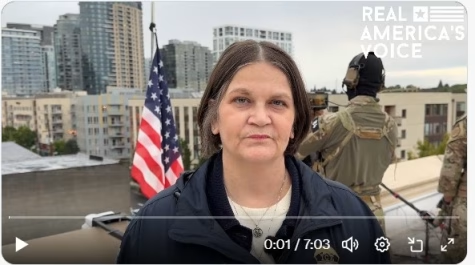In a recent interview with Real America’s Voice correspondent Ben Bergquam, Portland ICE Field Office Director Cammilla Wamsley pulled back the curtain on the daily challenges faced by Immigration and Customs Enforcement (ICE) officers in one of the nation’s most politically charged regions. Speaking from the rooftop of the Portland ICE Field Office, Wamsley outlined not only the logistics of her team’s work but also the growing hostility they face from activists, local politicians, and shifting public sentiment.
Wamsley described how the very layout of the Portland field office creates unique vulnerabilities. High-rise buildings overlook ICE operations, and she noted that officers have had to cover windows to block protesters and spotters from tracking their activities. “We’ve actually had to put up paper and blockages,” she explained, citing the risk of outsiders “dialing in” on ICE’s movements.
While daytime protests often appear peaceful to the casual observer, Wamsley emphasized that nighttime brings an entirely different atmosphere. Depending on the political climate, crowds can swell from a few dozen to thousands in a matter of hours. Spotters on the ground use networks to alert protesters of ICE activity, turning routine operations into flashpoints. “We’ve had up to 170 arrests connected to incidents at this building,” she noted, describing the often volatile standoffs.
Safety remains a top concern. ICE officers, Wamsley explained, wear masks not only for operational purposes but to protect their families from harassment and potential stalking. By contrast, she pointed out, many demonstrators arrive equipped with gas masks, helmets, and tactical gear. “Our folks are doing this for self-preservation,” she said, “while others come for nefarious reasons.”
WATCH:
Wamsley also reflected on the broader cultural shift surrounding immigration enforcement. “It used to be a policy debate,” she recalled, when disagreements centered on law and legislation. Today, she said, the conversation has turned personal, with activists targeting ICE employees themselves. “We are civil servants,” she stressed. “We’re here to enforce immigration laws as written. This is the job we’ve done for decades.”
The Director acknowledged the impact of “sanctuary” policies in Oregon and Washington, which prevent local jails from cooperating with ICE. In the past, she explained, ICE could safely transfer custody of individuals directly from correctional facilities with just one or two officers. Today, with limited cooperation from state and local partners, ICE must carry out “street arrests,” often requiring teams of five officers due to safety concerns. “Going into a prison is safer for our officers, safer for the public, and less disruptive,” she said.
Despite these challenges, Wamsley expressed optimism about new resources, including additional deportation officers, which she described as “game changing.” She also highlighted a shift toward prosecuting individuals who impede federal operations, warning that those actions can carry federal consequences.
Her message exposed both frustration and resolve: ICE officers remain committed to their mission, even as the political climate grows more hostile. “We are federal law enforcement officers,” Wamsley concluded. “Our job is outlined in federal law and federal regulation, and it cannot be ignored.”
